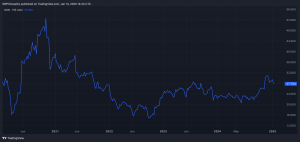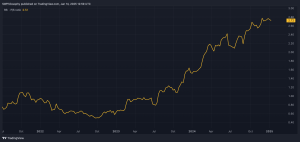Digital bank SoFi Technologies (NASDAQ: SOFI) has not had a great time so far this year. The growth stock has tumbled 26% since the start of 2024.
The $7.5bn market capitalisation is not insubstantial. Does this business, which has reported annual losses for the past few years, deserve such a valuation?
Might it be worth more, meaning the recent fall presents a buying opportunity for my portfolio? The chief executive has been buying SoFi stock over the past couple of months. Ought I to do that?
Why SoFi has been tumbling
SoFi has both fans and critics in the stock market.
It can be seen as an innovative digital bank and financial services provider that is investing now to build a loyal customer base for the future.
But it might also be seen as just one more player in a very crowded marketplace, where legacy banks have put effort into aping the innovations of smaller, nimble fintechs.
The US economy is not looking in great shape to me. There is a risk that it could deteriorate over the coming year. That might push up loan default rates.
That would be bad news for banks in general, including SoFi. But not all listed banks are suffering like it. Bank of America, for example, is up 17% this year, for a 34% gain in the share price over five years.
So I think the SoFi stock fall reflects wider concerns than just those of a recession and its possible implications for default levels.
Mixed recent performance
Partly I think it is because of the mixed picture presented by the company’s performance so far this year.
In the second quarter, there was positive news. SoFi reported its third consecutive quarter of profitability (using the Generally Accepted Accounting Principles or GAAP basis of preparation). Total net revenue was up 20% compared to the prior year period.
Still, diluted net income attributable to shareholders in the quarter was $8m. For a company with a market capitalisation of $7.5bn, that is small beer – though it could be that we see growth from here, explaining the market cap.
What about defaults? The weighted average annual default rate for both personal loans and student loans was unchanged from one year previously.
However, there were some potential warning signs of a deteriorating environment. While personal and student loan default rates were flat, there was an increase in the unpaid balance. That could suggest that borrowers are paying less than before, potentially because their financial situations are getting tighter even if for now they are avoiding default.
Work to be done
On balance, I thought the second quarter, although mixed, was mostly positive for the firm. I reckon its focus on meeting a wide range of financial needs for a specific client type could help it do well in future.
But even after the drop, SoFi does not strike me as a bargain growth stock for my portfolio at its current valuation.
The risks posed by a weak US economy that could get weaker in coming years concern me. Unlike many larger and far older banks, SoFi lacks experience in navigating a US financial crash.
This post was originally published on Motley Fool






